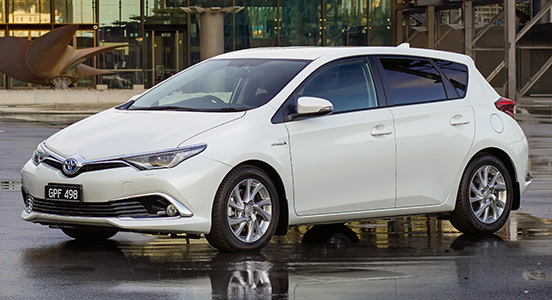New Toyota Corolla Hybrid has arrived
Toyota has just launched an exciting new addition to the Corolla family. The fleet favourite is now available with Hybrid Synergy Drive® technology, and that’s great news for many Australian fleets.
New Toyota Corolla Hybrid uses around one-third less fuel – approx. 4.1L/100km1, while still producing similar power (100kW) to the already efficient petrol-only auto Corolla Hatch.
Fitted with a Euro 5 compliant 1.8-litre petrol engine mated to a 60kW electric motor, New Corolla Hybrid delivers three drive modes on top of standard – ECO for fuel efficiency, EV (electric vehicle – car runs on the electric motor alone) and POWER for more responsive driving. Plus, it comes with the 5-star ANCAP safety rating you’d expect from Corolla, to keep your passengers safe.
Premium features include Satellite Navigation2, Dual-zone automatic climate control, 4.2” colour Multi-Information Display and Bi-LED headlamps. Smart Entry and Start system ensure drivers waste no time getting on the road, while the double wishbone rear suspension adds comfort to any drive.
With low CO2 emissions – just 96g/km1 – New Corolla Hybrid is ideal for the environmentally conscious fleet and an exciting extension to Toyota’s Hybrid range.
To find out more, visit toyota.com.au/fleet or call 1800 444 847.
1 Fuel consumption and emissions will vary depending on driving conditions/style, vehicle conditions and options/accessories. Source of fuel consumption data: ADR 81/02 combined cycle.
2 Current navigation mapping database encompasses major capital and primary national road networks and offers some coverage in regional areas.
Announcing our Europcar/Toyota/Virgin Airlines competition winner
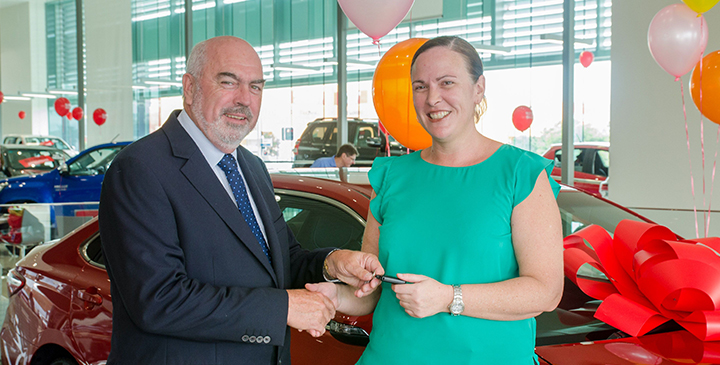
When Susan Dodd clicked on a Facebook ad to win a Toyota Camry, she never dreamed anything would come of it. So the speech therapist from Townsville says she couldn’t believe it when she heard she’d won. “I was so excited! I had to pinch myself.”
To be in the running, entrants had to have booked a Virgin Airlines flight and hired a vehicle through Europcar. “I’m a Virgin member and we frequently use Europcar – the cars are always ready on arrival and they frequently offer upgrades”, says Susan. “On this occasion we were visiting family in Brisbane and Melbourne.”
Toyota Fleet and Europcar are long standing partners and we are very proud to have worked together to create this opportunity.
Smart and spacious, Toyota Camry has a well-earned reputation as Australia’s best-selling mid-size sedan. It’s designed for Australia’s everyday heroes – families – so it was the perfect prize for Sue who is married with two children.
“I’d like to say a big thank you to Toyota, Europcar and Virgin Airlines for making it all possible. I never expected to win, but I’m extremely happy I did. Oh what a feeling!” she says.
Vote of Conference
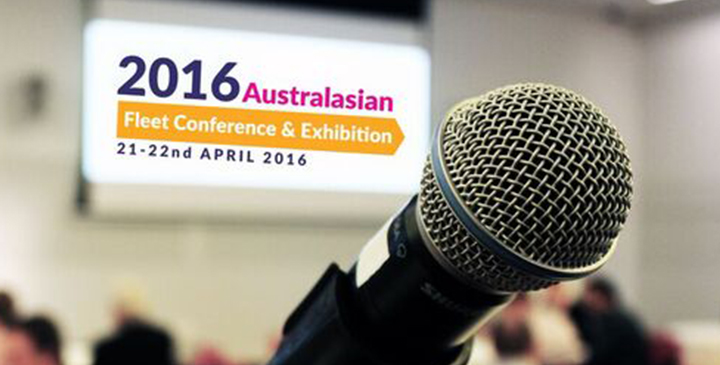
Reducing Costs & Increasing Safety Through Technology: an objective of every Fleet Manager and the theme of the 2016 Australasian Fleet Conference & Exhibition, proudly sponsored by Toyota Fleet and Toyota Fleet Management.
Australasian Fleet Management Association hosted the April event in Melbourne, with the non-profit vision to give fleet managers a voice and promote fleet management as a legitimate, commendable profession by bringing business and industry, manufacturers, government and equipment suppliers together to discuss the key issues impacting fleet management.
ANCAP CEO Wendy Machin’s keynote speech was the most sobering of all. “Don’t be complacent,” she said. “As fleet buyers, you have massive influence over the motoring industry; manufacturers will respond if you demand safety features. Auto Emergency Breaking should be on every buyer’s list.”
Wendy reminded how important a five-star ANCAP rated vehicle is. “Since the 90s, ANCAP has helped turn safety from an industry-shy topic, to being the top priority,” she said. “Focus has gone from crumple zones and airbags to Safety Assist Technologies that will lead to driverless cars. We’ve come a long way.”
Day one’s Technology Saving Money: Driverless Cars plenary had everyone’s attention with reasons to welcome autonomous motoring to Australia. Fleets with myriad semi-autonomous safety-assist features will accelerate the transition to autonomy; shorten commutes, lessen congestion, improve productivity and increase personal time. Go further than base models with rudimentary safety gear (airbags and ABS).
Other sessions included the popular RACV Driver Training two-part theory and practical course, digesting Fringe Benefit Tax changes thanks to Simon Ellis at KPMG, and Choosing Fleet Maintenance Options. Particularly intriguing was Influencing Outcomes: Negotiating Skills & Emotional Intelligence with Nicole Davidson from CMA Learning explaining how to achieve goals through positivity and encouragement in fleet management. Jim Appleby from Downer Group took a no frills approach to near misses in Zero Harm: Creating a Safety Culture; and Kristian Handberg from AGL opened our eyes to the EV march saving fleets oodles on fuel, servicing and CO2.
Spark Helmore Lawyers’ Nicole Fauvrelle in Our Car, Your Car, It’s Our Responsibility offered possibly the Conference’s best value with staunch legal advice. “So many factors contribute to road crashes today, it’s crucial to set robust, relevant, appropriate and enforceable policies and procedures to facilitate safety and protect your biggest asset, your people.”
A wide range of speakers and topics made it clear that you’ve never had more influence and it makes perfect business sense to invest in safety, protect your business and save money – that’s doing more with less.
Go to afma.net.au for information about their Professional Development Forums and next year’s Conference.
Connected Cars – The Next Safety Advance
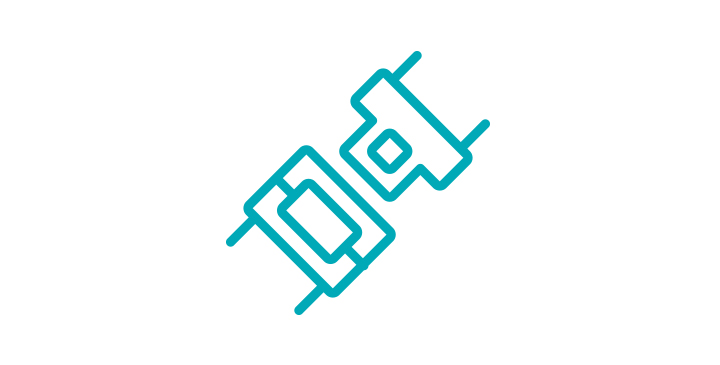
A dazzling array of safety-related technology is available in many of today’s cars including pre-collision systems, automatic braking, blind-spot monitoring, detection of lane markings and barriers with steering assist and adaptive cruise control.
While technology can therefore play a vital role in promoting safety, there are still many injuries from road accidents due mainly to human error. Faced with this challenge, automotive companies are continuing to develop and deploy a range of in-car technologies designed to support awareness by drivers of their surroundings and to help them avoid danger.
In coming years, there are some truly exciting technologies that will revolutionise the automotive industry and human transport in general, transforming the way we drive and increasing automotive safety dramatically. These advances come under the banner of the “connected cars” and are now the subject of serious research that will enable vehicles to communicate with each other and with objects around them.
Vehicle-to-vehicle (V2V) communications will involve sending wireless signals between cars, providing details about their location, direction of travel and speed. While the algorithms required to calculate this information and determine evasive measures are massively complicated, a simple example illustrates the potential benefits. Imagine you are driving the last vehicle in a long line of traffic and the first vehicle is forced to brake suddenly due to a hazard. As the vehicles in front of you respond by slamming on their brakes, you may be unable to react quickly enough – particularly if you cannot see the initial incident. In the future, though, V2V technology will enable the front car to issue an instant warning to other cars on the road, helping to avoid a dangerous pile-up.
Researchers are also developing and testing vehicle-to-infrastructure (V2I) communication, which is designed to allow vehicles to communicate with traffic signals and other sources of information relating to safety. V2I could also request traffic information from a traffic management system and access the best possible routes. The combination of V2V and V2I technologies could save your life in the following situation. You are approaching a green traffic light and another car is driving through the red light at the same intersection. Both cars will receive a signal from the traffic lights that enables them to send a warning to the other vehicle, or even operate the brakes automatically to avoid an accident.
The National Highway Traffic Safety Administration in the United States, in a study issued several years ago, said these combined technologies had the potential to reduce 81 per cent of target vehicle crashes on the road.
Our driving future will also incorporate augmented reality. Even today, some vehicles offer displays on the windshield, but this is just the start. Augmented Reality dashboards are coming. They will be able to identify and inform the driver about objects on the road ahead – even ones the driver can’t see, such as at night. Importantly, systems are being developed that will show you how to avoid a collision. There are many other potential uses for augmented reality in the automotive industry; for example, repair technicians using special optics will be able to use the technology to determine what components need to be replaced.
Importantly, these advanced technologies will not be solely the preserve of luxury cars. Connected car technology is expected to follow the same pattern of devices such as anti-skid brakes and airbags, which have become universal. The result will be safer cars and safer roads for everyone.
Toyota lends helping hand – and 2 HiAce buses – to the Salvos
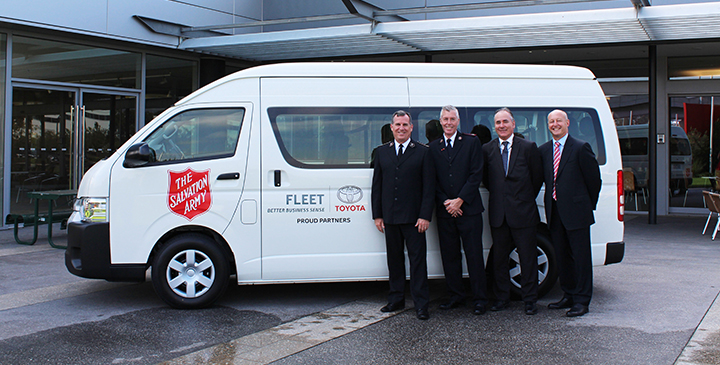
There’s no end to the great work The Salvation Army does in the community. So when Toyota had the chance to give something back to the Salvos, the company was only too happy to help out, providing two Toyota HiAce buses for their Southern and Eastern Regions.
Fleet Manager Trent Marsh explains that The Salvation Army has enjoyed a partnership with Toyota for over a decade, and the two HiAce buses have been particularly welcome additions to their fleet family.
“Our fleet has always included Toyota vehicles – including Corolla, Camry, Camry Hybrid, RAV4, HiLux and LandCruisers – because of their reliability, value and affordable servicing,” says Trent. “Now the HiAce Commuter buses, with their modifiable seating arrangements, are especially useful for the work we do.”
The buses are being used to transport less mobile members of the community, taking children to Sunday School and Youth Group, as well as ferrying the elderly who may be housebound or no longer able to drive.
“One bus has also been transporting volunteers, providing lawn maintenance to older folk, the disabled and the disadvantaged,” adds Gaye Day, Eastern Region Corps Officer. “Plus we’re using them for Food Rescue – picking up food from local shops and delivering it to those in need.”
So what makes the HiAce a standout vehicle for The Salvation Army?
“We always look for great value and reliability in our vehicles, because as a fleet manager, the most important thing is usually trouble-free motoring. But when you’re caring for children and the elderly, that needs to be balanced with the comfort and safety you get with the HiAce Commuter buses,” says Trent.
Trent gives a special shout out to Toyota’s Darren Ryan, Business Fleet Manager of the Eastern Region Office, for fantastic customer service. “Nothing is ever too much of an issue and they look after us well. That’s why we keep coming back.”

